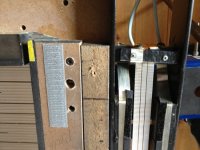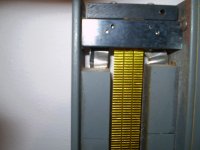Was the Apogee Duette a ribbon speaker or a magnetostat?
And if the former: wouldn't it have to have a transformer to bring the impedance to amplifier-friendly values?
Many greetings,
Michael
And if the former: wouldn't it have to have a transformer to bring the impedance to amplifier-friendly values?
Many greetings,
Michael
You don't need a transformer the speaker is 4 Ohm.Was the Apogee Duette a ribbon speaker or a magnetostat?
And if the former: wouldn't it have to have a transformer to bring the impedance to amplifier-friendly values?
Many greetings,
Michael
Yes you are correctI would guess it’s both. The woofer is magnetostatic and the tweeter a ribbon ?
Rob
You typically see transformers on smaller, wider ribbons where their dimensions lead to very low impedances. With longer, skinnier ribbons, impedance can be high enough to drive directly.wouldn't it have to have a transformer to bring the impedance to amplifier-friendly values?
I've a pair of Apogee Duetta Signatures in my collection. They're not ribbons. The bass panel is a single-ended planar-magnetic diaphragm (foil voice coil glued to a kapton backer and secured on all sides over a bed of magnets) while the midrange/tweeter is a quasi-ribbon (foil voice coil on a kapton backer suspended by the narrow ends between a column of magnets to either side).
Though Apogee marketed their speakers heavily as "full-range ribbons", that was just pure marketing bull. The only actual ribbons in Apogees were on the handful of top models that used a true ribbon (foil only) as a supertweeter above 10kHz.
Though Apogee marketed their speakers heavily as "full-range ribbons", that was just pure marketing bull. The only actual ribbons in Apogees were on the handful of top models that used a true ribbon (foil only) as a supertweeter above 10kHz.
My only experience with Apogee was the Caliper model. The tweeter was kinda ribbon-like, a strip of foil with magnets on each side.... but I May be wrong.
Quasi-ribbon. Strip type planar-diaphragm suspended like a ribbon. The foil on the front can trick you, but the yellow of the kapton is obvious from the back:My only experience with Apogee was the Caliper model. The tweeter was kinda ribbon-like, a strip of foil with magnets on each side.... but I May be wrong.


Actually and factually the Full Range and the Scintilla used pure foil ribbons crossed over at around 300hz and up. I own the Scintilla model in the 1 ohm configuration.I've a pair of Apogee Duetta Signatures in my collection. They're not ribbons. The bass panel is a single-ended planar-magnetic diaphragm (foil voice coil glued to a kapton backer and secured on all sides over a bed of magnets) while the midrange/tweeter is a quasi-ribbon (foil voice coil on a kapton backer suspended by the narrow ends between a column of magnets to either side).
Though Apogee marketed their speakers heavily as "full-range ribbons", that was just pure marketing bull. The only actual ribbons in Apogees were on the handful of top models that used a true ribbon (foil only) as a supertweeter above 10kHz.
Semantics.
I consider the mylar-backed tweeter/mid ribbons of the cheaper Apogee models to be true ribbons.
The physical layout of the magnets and suspension configuration of the driver within the gap is not different than those that don't utilize mylar. The mylar exists in these configurations to stabilize the ribbon element, but it doesn't alter the basic motor structure.
Dave.
I consider the mylar-backed tweeter/mid ribbons of the cheaper Apogee models to be true ribbons.
The physical layout of the magnets and suspension configuration of the driver within the gap is not different than those that don't utilize mylar. The mylar exists in these configurations to stabilize the ribbon element, but it doesn't alter the basic motor structure.
Dave.
I agree Davey. I consider quasi ribbons to be the likes of the Infinity planar mid/treble drivers.
- Home
- Loudspeakers
- Planars & Exotics
- Apogee Duette - Ribbon or magnetostat?